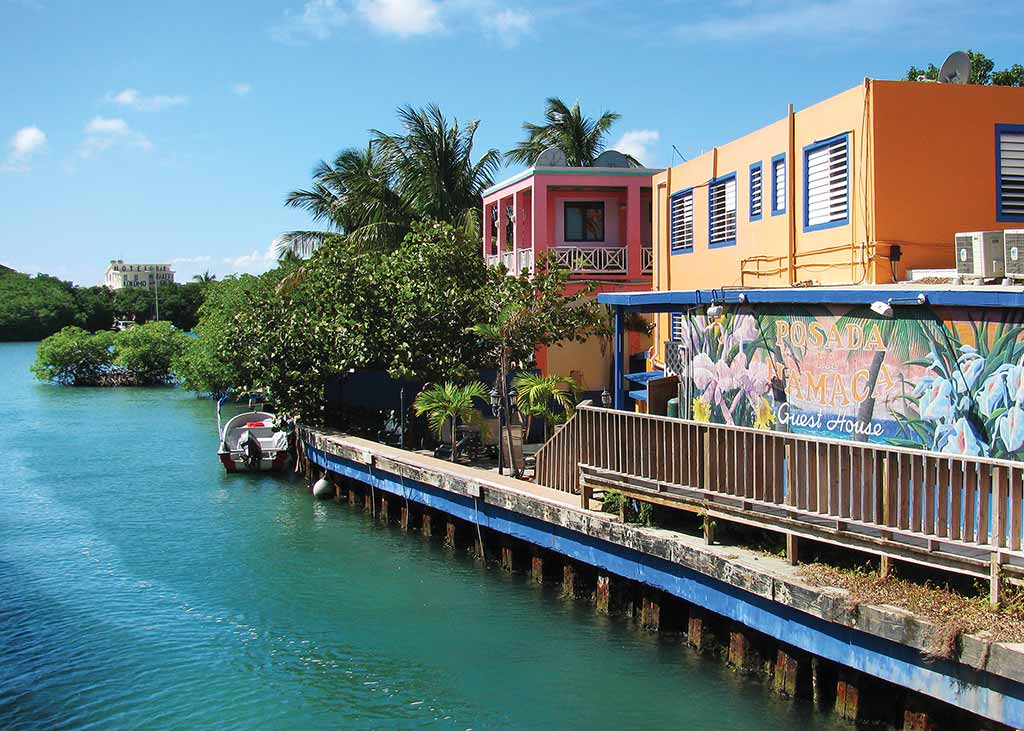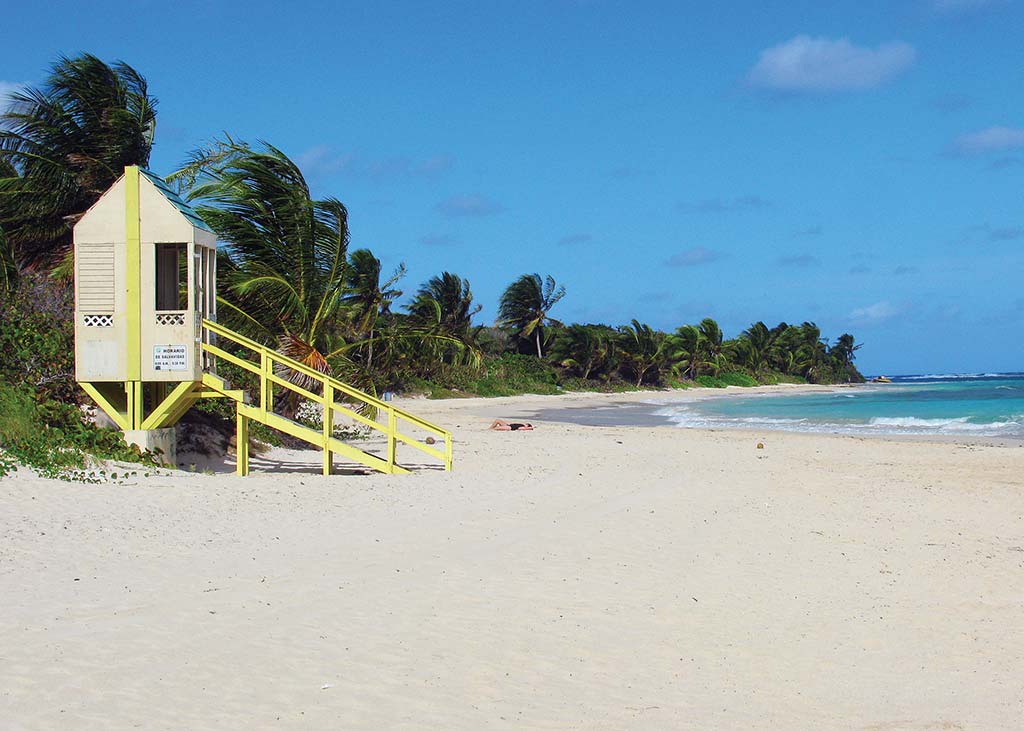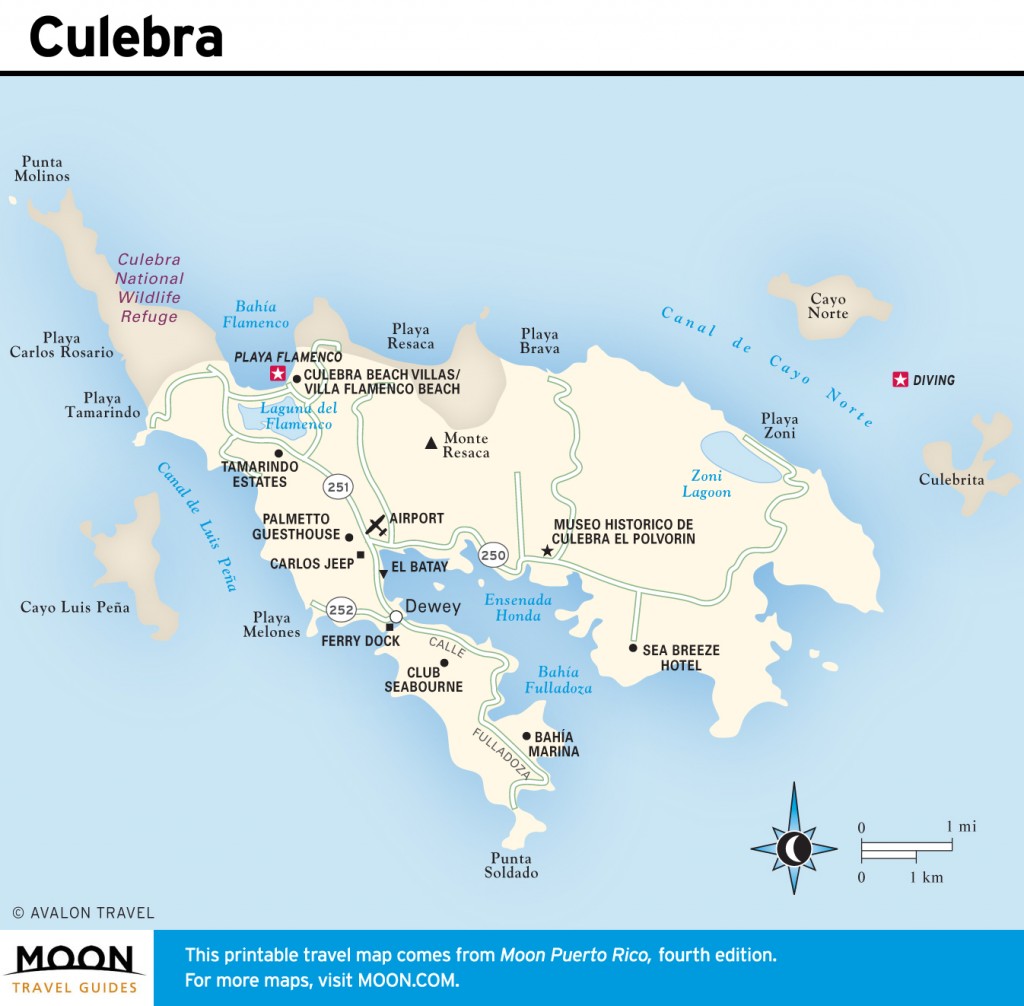As laid-back as Vieques is, it’s practically Las Vegas compared to Culebra. Halfway between mainland Puerto Rico and St. Thomas, the tiny amoeba-shaped archipelago with 23 surrounding cays is just four miles by seven miles. The island is home to 3,000 residents and has one small community—Dewey (commonly called “Pueblo” or “Town”)—on Ensenada Honda harbor, where the ferry docks.

The canal in Dewey, Culebra. Photo © Suzanne Van Atten.
Because water is shipped from San Juan, shortages are not unusual, and pressure is often low.Culebra has yet to be discovered by the tourism industry, but experienced divers know it as one of the best diving spots in the Caribbean. The clear, clean waters are practically untouched by people and their polluting by-products, thanks in part to the arid island’s absence of rivers or streams. The result is superb underwater visibility and healthy, intact coral systems that support a wide variety of sea life.In 1909, recognizing the island’s vital role as a natural wildlife habitat, President Theodore Roosevelt proclaimed much of the island a National Wildlife Refuge, which today encompasses 1,568 acres. Nonetheless, in 1939, the U.S. Navy made Culebra its primary gunnery and bomb practice site and continued its operations here until 1975, when it turned its focus to Vieques.
The island is a combination of hilly terrain with dry subtropical forest and a highly irregular coastline punctuated by cliffs, mangrove forests, and spectacular sandy coral beaches. Because it is so sparsely inhabited, Culebra is home to many endangered species and is an important nesting site for birds and sea turtles. Playa Flamenco is celebrated as one of the best beaches in the United States. But there are many other smaller beaches to discover, some completely deserted much of the time.
Accommodations in Culebra are mostly small mom-and-pop guesthouses, some little more than spare bedrooms. The operations here are mostly self-serve. In fact, it’s not unusual for visitors to have the run of the place when owners decide to head to the beach or bar to while away the day. But a handful of small luxury hotels and condo rental units service travelers who want more modern-day amenities. At the dozen or so restaurants, service typically moves at a snail’s pace, and there are a couple of bars, but little real nightlife.
Because water is shipped from San Juan, shortages are not unusual, and pressure is often low. Some smaller properties have limited hot water or none at all. Plumbing in general can be problematic—the standard practice is to discard toilet paper in the trash instead of flushing it. And alarm clocks are never necessary, because you’re sure to be woken by one of the roosters that roam the island. An anomaly in the world, Culebra is virtually crime-free. Instead of petty theft, visitors need only brace themselves against the voracious mosquitoes and sand gnats that tend to invade around dusk.
Culebra is one of the last vestiges of pre-tourism Puerto Rico. Nobody is in a hurry, modern conveniences are few, and all anybody really wants to do is go to the beach. That’s the way people in Culebra like it, and most of them want to keep it that way. Visitors are advised to embrace the island’s quirky inconveniences and sleepy pace of life to fully appreciate its many rare charms.

Playa Flamenco in Culebra. Photo © Suzanne Van Atten.
If you spend any time in Culebra, you’re bound to enter the Culebra National Wildlife Refuge (787/742-0115, Mon.-Fri. 7:30am-4pm, free). It encompasses 1,568 acres, including much of Flamenco Peninsula, where 60,000 sooty terns nest, as well as mangrove forests, wetlands, coastline, surrounding cays (except Cayo Norte), and Monte Resaca, the island’s highest point at 650 feet, which contains forested canyons, ravines, and a unique habitat known as the boulder forest. The refuge contains excellent beaches, diving, bird-watching, and hiking. Culebrita, Cayo Luis Peña, and Monte Resaca are open daily sunrise-sunset. Other areas are off-limits to visitors. For maps and information, visit the refuge office, east on Carretera 250, just past the cemetery.

Culebra
Museo Histórico de Culebra El Polvorin (off Carr. 250 toward Playa Brava, 787/405-3768 or 787/742-3832, Thurs.-Sun. 10am-3pm, free) is a museum of history on the island that features old maps and photographs of Culebra, Taíno artifacts, traditional canoes made from the zinc plant, and Navy artifacts. It’s located at the site of the first settlement in Culebra, in a 1905-era stone building that once stored ammunition for the Navy.
Culebra is one of three nesting grounds for hawksbill and leatherback turtles, the latter of which is the largest species of turtle in the world, weighing between 500 and 1,600 pounds. From April to early June, the sea turtles spend the evenings trudging up the beach at Playa Resaca and Playa Brava to dig holes and lay eggs before returning to the sea in grand displays of sand-tossing to cover their tracks. Visitors are not permitted on the beaches at night during nesting season.
Excerpted from the Fourth Edition of Moon Puerto Rico.